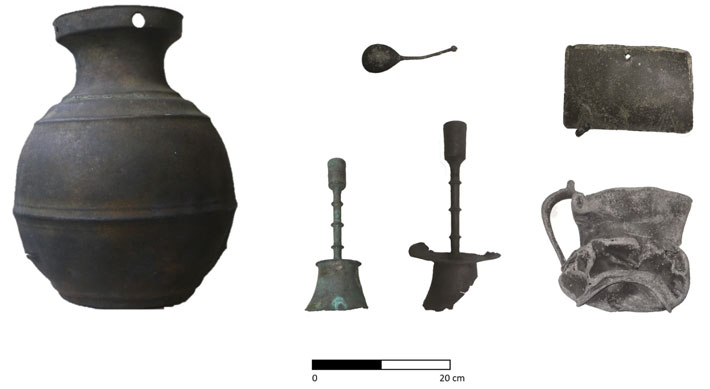 ESPOSENDE, PORTUGAL—ArtNet News reports that a study of artifacts that washed ashore in Portugal about 10 years ago suggests that they did not come from the wreckage of the Nossa Senhora da Rosa, an Iberian vessel carrying wine that sank in 1577, as had been previously thought. The artifacts include 490 pewter fragments, and 254 pewter plates, porringers, and spoons. Marks on these pewter objects indicate that they were made in European workshops in the sixteenth century. The researchers also determined that the 125 copper fragments recovered on Portugal’s Belinho Beach came from 34 plates. Biblical and religious decorations, including images of Adam and Eve and St. George fighting a dragon, suggest that these were alms dishes resembling those produced in Nuremberg, Germany. X-rays of seven highly degraded iron items among the collection identified two ax heads, at least two swords, and one nail. Cannonballs of various sizes and two pieces of glazed ceramic were also identified. Researchers now think the ship belonged to a sixteenth-century merchant who was transporting goods made in northern Europe for use on other ships. The study also suggests that the ship’s cargo was loaded all at once. Its destination remains undetermined, however. Read the original scholarly article about this research in Journal of Maritime Archaeology. To read about examination of artifacts recovered from a seventeenth-century shipwreck in the Wadden Sea, go to "An Elegant Enigma."
ESPOSENDE, PORTUGAL—ArtNet News reports that a study of artifacts that washed ashore in Portugal about 10 years ago suggests that they did not come from the wreckage of the Nossa Senhora da Rosa, an Iberian vessel carrying wine that sank in 1577, as had been previously thought. The artifacts include 490 pewter fragments, and 254 pewter plates, porringers, and spoons. Marks on these pewter objects indicate that they were made in European workshops in the sixteenth century. The researchers also determined that the 125 copper fragments recovered on Portugal’s Belinho Beach came from 34 plates. Biblical and religious decorations, including images of Adam and Eve and St. George fighting a dragon, suggest that these were alms dishes resembling those produced in Nuremberg, Germany. X-rays of seven highly degraded iron items among the collection identified two ax heads, at least two swords, and one nail. Cannonballs of various sizes and two pieces of glazed ceramic were also identified. Researchers now think the ship belonged to a sixteenth-century merchant who was transporting goods made in northern Europe for use on other ships. The study also suggests that the ship’s cargo was loaded all at once. Its destination remains undetermined, however. Read the original scholarly article about this research in Journal of Maritime Archaeology. To read about examination of artifacts recovered from a seventeenth-century shipwreck in the Wadden Sea, go to "An Elegant Enigma."
New Thoughts on a 16th-Century Ship’s Cargo
